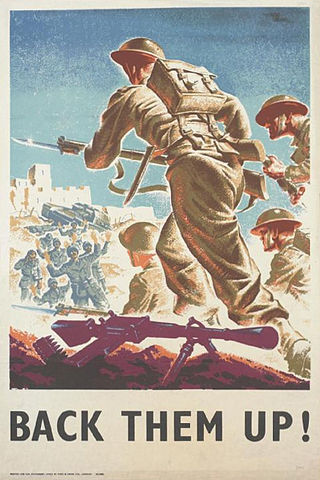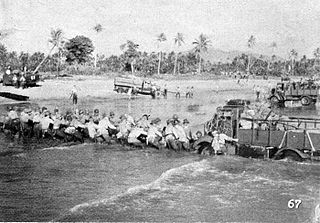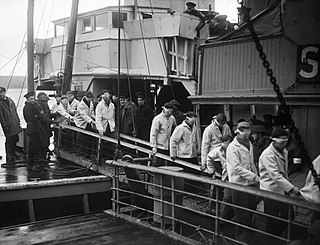Related Research Articles

A prisoner of war (POW) is a person who is held captive by a belligerent power during or immediately after an armed conflict. The earliest recorded usage of the phrase "prisoner of war" dates back to 1610.

Other Losses is a 1989 book by Canadian writer James Bacque, which makes the claim that U.S. General Dwight D. Eisenhower intentionally caused the deaths by starvation or exposure of around a million German prisoners of war held in Western internment camps after the Second World War. Other Losses charges that hundreds of thousands of German prisoners that had fled the Eastern front were designated as "Disarmed Enemy Forces" in order to avoid recognition under the Geneva Convention (1929), for the purpose of carrying out their deaths through disease or slow starvation. Other Losses cites documents in the U.S. National Archives and interviews with people who stated they witnessed the events. The book claims that a "method of genocide" was present in the banning of Red Cross inspectors, the returning of food aid, soldier ration policy, and policy regarding shelter building.

A commando is a combatant, or operative of an elite light infantry or special operations force, specially trained for carrying out raids and operating in small teams behind enemy lines.

The military history of the United Kingdom in World War II covers the Second World War against the Axis powers, starting on 3 September, 1939 with the declaration of war by the United Kingdom and France, followed by the UK's Dominions, Crown colonies and protectorates on Nazi Germany in response to the invasion of Poland by Germany. There was little, however, the Anglo-French alliance could do or did do to help Poland. The Phoney War culminated in April 1940 with the German invasion of Denmark and Norway. Winston Churchill became prime minister and head of a coalition government in May 1940. The defeat of other European countries followed – Belgium, the Netherlands, Luxembourg and France – alongside the British Expeditionary Force which led to the Dunkirk evacuation in June 1940.

The Rheinwiesenlager were a group of 19 concentration camps built in the Allied-occupied part of Germany by the U.S. Army to hold captured German soldiers at the close of the Second World War. Officially named Prisoner of War Temporary Enclosures (PWTE), they held between one and almost two million surrendered Wehrmacht personnel from April until September 1945.

The final battles of the European theatre of World War II continued after the definitive surrender of Nazi Germany to the Allies, signed by Field marshal Wilhelm Keitel on 8 May 1945 in Karlshorst, Berlin. After German leader Adolf Hitler's suicide and handing over of power to grand admiral Karl Dönitz on the last day of April 1945, Soviet troops conquered Berlin and accepted surrender of the Dönitz-led government. The last battles were fought on the Eastern Front which ended in the total surrender of all of Nazi Germany’s remaining armed forces such as in the Courland Pocket in western Latvia from Army Group Courland in the Baltics surrendering on 10 May 1945 and in Czechoslovakia during the Prague offensive on 11 May 1945.
The Commando Order was issued by the OKW, the high command of the German Armed Forces, on 18 October 1942. This order stated that all Allied commandos captured in Europe and Africa should be summarily executed without trial, even if in proper uniforms or if they attempted to surrender. Any commando or small group of commandos or a similar unit, agents, and saboteurs not in proper uniforms who fell into the hands of the German forces by some means other than direct combat, were to be handed over immediately to the Sicherheitsdienst for immediate execution.

The Indian Army during World War II, a British force also referred to as the British Indian Army, began the war, in 1939, numbering just under 200,000 men. By the end of the war, it had become the largest volunteer army in history, rising to over 2.5 million men in August 1945. Serving in divisions of infantry, armour and a fledgling airborne force, they fought on three continents in Africa, Europe and Asia.

Disarmed Enemy Forces is a US designation for soldiers who surrender to an adversary after hostilities end, and for those POWs who had already surrendered and were held in camps in occupied German territory at the time. It was General Dwight D. Eisenhower's designation of German prisoners in post–World War II occupied Germany.

A ship is scuttled when its crew deliberately sinks it, typically by opening holes in its hull.

Japanese Surrendered Personnel (JSP) was a designation for Japanese prisoners of war developed by the government of Japan in 1945 after the end of World War II in Asia. It stipulated that Japanese prisoners of war in Allied custody would be designated as JSP, which were not subject to the Third Geneva Convention's rules on prisoners, and had few legal protections. The Japanese government presented this proposal to the Allies, which accepted it even though the concept lacked a legal basis, as they were suffering from manpower shortages.
During World War II, the Allies committed legally proven war crimes and violations of the laws of war against either civilians or military personnel of the Axis powers. At the end of World War II, many trials of Axis war criminals took place, most famously the Nuremberg Trials and Tokyo Trials. In Europe, these tribunals were set up under the authority of the London Charter, which only considered allegations of war crimes committed by people who acted in the interests of the Axis powers. Some war crimes involving Allied personnel were investigated by the Allied powers and led in some instances to courts-martial. Some incidents alleged by historians to have been crimes under the law of war in operation at the time were, for a variety of reasons, not investigated by the Allied powers during the war, or were investigated but not prosecuted.
In the context of war, perfidy is a form of deception in which one side promises to act in good faith with the intention of breaking that promise once the unsuspecting enemy is exposed.

The Geneva Convention on Prisoners of War was signed at Geneva, July 27, 1929. Its official name is the Convention relative to the Treatment of Prisoners of War, Geneva July 27, 1929. It entered into force 19 June 1931. It is this version of the Geneva Conventions which covered the treatment of prisoners of war during World War II. It is the predecessor of the Third Geneva Convention signed in 1949.

Australia entered World War II on 3 September 1939, following the government's acceptance of the United Kingdom's declaration of war on Nazi Germany. Australia later entered into a state of war with other members of the Axis powers, including the Kingdom of Italy on 11 June 1940, and the Empire of Japan on 9 December 1941. By the end of the war, almost one million Australians had served in the armed forces, whose military units fought primarily in the European theatre, North African campaign, and the South West Pacific theatre. In addition, Australia came under direct attack for the first time in its post-colonial history. Its casualties from enemy action during the war were 27,073 killed and 23,477 wounded. Many more suffered from tropical disease, hunger, and harsh conditions in captivity; of the 21,467 Australian prisoners taken by the Japanese, only 14,000 survived.

The Dutch East Indies campaign of 1941–1942 was the conquest of the Dutch East Indies by forces of the Empire of Japan in the early days of the Pacific campaign of World War II. Allied forces attempted unsuccessfully to defend the islands. The East Indies were targeted by the Japanese for their rich oil resources which would become a vital asset during the war. The campaign and subsequent three-and-a-half-year Japanese occupation was also a major factor in the end of Dutch colonial rule in the region.

The siege of Dunkirk in World War II began in September 1944, when Allied units of the Second Canadian Division surrounded the fortified city and port of Dunkirk. The siege lasted until after the official end of the war in Europe. German units within the fortress withstood probing attacks and as the opening of the port of Antwerp was more important, the 21st Army Group commander, Field Marshal Bernard Montgomery, decided to contain but not capture Dunkirk with the 1st Czechoslovak Armoured Brigade. The fortress, commanded by Admiral Friedrich Frisius, eventually surrendered unconditionally to Brigadier General Alois Liška, the commander of the Czechoslovak brigade group, on 9 May 1945, a day after the surrender of Nazi Germany took effect.

During World War II, it was estimated that between 35,000 and 50,000 members of the Imperial Japanese Armed Forces surrendered to Allied servicemembers prior to the end of World War II in Asia in August 1945. Also, Soviet troops seized and imprisoned more than half a million Japanese troops and civilians in China and other places. The number of Japanese soldiers, sailors, marines, and airmen who surrendered was limited by the Japanese military indoctrinating its personnel to fight to the death, Allied combat personnel often being unwilling to take prisoners, and many Japanese soldiers believing that those who surrendered would be killed by their captors.

The Battle of Rhodes took place between Italian and German forces for the control of Rhodes, a Greek island in the Italian (1912–1943) Dodecanese islands in the Aegean Sea. The Italian authorities in Rome had been negotiating the Armistice of Cassibile with the Allies and the Germans had been manoeuvring to launch a coup in Italy and Italian-garrisoned areas in southern Europe, at the first sign of treachery to the Axis. German troops had been sent to Rhodes with tanks, artillery and air support. The British deception Operation Mincemeat intended to divert German attention from Sicily may have added to German apprehensions over the Aegean area.

Large numbers of German prisoners of war were held in Britain between the outbreak of the Second World War in September 1939 and late 1948. Their numbers reached a peak of around 400,000 in 1946, and then began to fall when repatriation began. The experiences of these prisoners differed in certain important respects from those of captured German servicemen held by other nations. The treatment of the captives, though strict, was generally humane, and fewer prisoners died in British captivity than in other countries. The British government also introduced a programme of re-education, which was intended to demonstrate to the POWs the evils of the Nazi regime, while promoting the advantages of democracy. Some 25,000 German prisoners remained in the United Kingdom voluntarily after being released from prisoner of war status.
References
This article needs additional citations for verification .(October 2007) |
- ↑ Hanrei Taimuzu (The Law Times Report) No. 703, 63. X1, X2, X3 et al. v. The State of Japan Archived 2011-07-22 at the Wayback Machine (Tokyo District Court, judgment, 1989, Case No. wa-4024, wa-8983 (1981), wa-731 (1982), wa-12166 (1985)). pp. 7,8
- ↑ Madsen, Chris. The Royal Navy and German Naval Disarmament, 1942-1947, Routledge, 1998 ISBN 0-7146-4823-X. p. 90
- ↑ Nagl John A. Counterinsurgency Lessons from Malaya and Vietnam: Learning to Eat Soup with a Knife, Greenwood Publishing Group, 2002 ISBN 0-275-97695-5. p. 92
- ↑ Ingrid Detter Delupis, "The Law of War" (google books p.328)